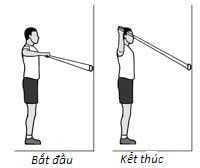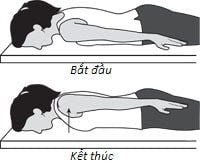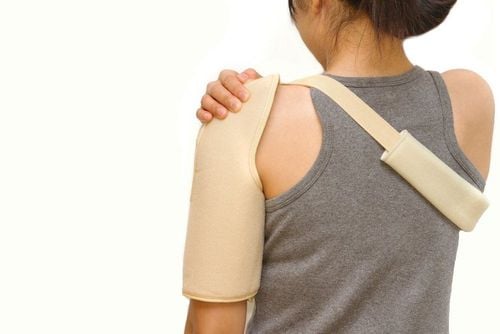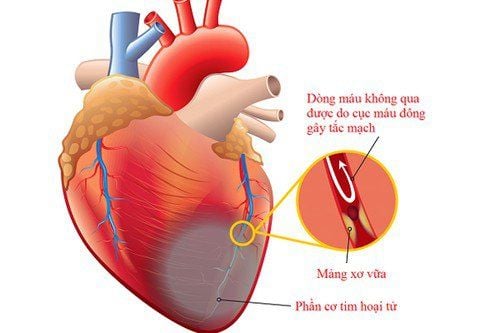This is an automatically translated article.
The article is professionally consulted by Master, Specialist Doctor I Nguyen Thi Thanh Binh - Rehabilitation Doctor - Department of General Surgery - Vinmec Da Nang International General Hospital. The doctor has 30 years of experience in the specialty of Rehabilitation, especially experienced in Rehabilitation of musculoskeletal diseases.The shoulder joint is the most complex joint in the human body, providing the mobility to move the arm 360 degrees and allowing most of the bones, muscles, tendons, and ligaments of the upper body to work together. together. Due to many components, when injured or diseased, the shoulder joint is often painful or incapacitated. If you are experiencing shoulder pain, try the following shoulder exercises to relieve pain and restore function.
1. Pendulum exercise
You can start this exercise by leaning forward and placing one hand on the edge of a shelf, cabinet, or table for support. The other arm is free. Gently swing your arms forward and back. S then swings the arm side to side from side to side and finally makes a swinging motion like a pendulum. Repeat the exercise with the opposite arm, but taking care not to reach too far behind your back or touch your knees.2. Stretch your arms
You begin the arm stretch by relaxing one shoulder. The other forearm gently pull and hold the other arm across the chest as far as possible, holding by clamping between the forearm and the anterior chest wall. Hold the stretch for 30 seconds, you should feel a stretch in the back of your shoulder, and then relax for 30 seconds. Repeat the exercise with the opposite arm. Take care not to pull or put pressure on the elbow.3. Inner shoulder rotation
When performing this exercise, bring your hands behind your back and hold the ends of a stick. The one-hand grip pulls the club toward the same side as much as possible, hold for 30 seconds, you should feel a stretch in the front of the opposite shoulder, and then relax for 30 seconds. Repeat the exercise with the opposite arm. Take care to keep your legs and entire body straight, and do not lean or twist to the side while pulling the club.
4. External shoulder rotation
When performing the external shoulder rotation exercise, you need to bring your arms close to your torso, forearms bent 90 degrees facing forward. Two hands hold the ends of a stick.One hand and forearm push the clubhead to the opposite side causing the opposite forearm to rotate out as far as possible. Hold for 30 seconds, you should feel a stretch in the back of your shoulder, and then relax for 30 seconds. Repeat the exercise with the opposite arm. Notice that the arms are always close to the body and do not bend forward or grind.
5. Pull the hand to lie down
Perform this exercise by lying on your side on a flat surface and resting your head on a pillow for comfort. The lower arm is perpendicular to the torso and the forearm is perpendicular to the plane in which it is lying with the hand facing up.Take the forearm on the opposite side to push the forearm of the lower shoulder against the plane so that the fingers are facing the leg. Hold this position for 30 seconds, you should feel a stretch in your upper back and behind your shoulders, then relax your arms for 30 seconds. Repeat the exercise with the opposite arm. Be careful not to try to push down if you feel too much tension in the back wall of the lower shoulder. Do not bend the wrist or simply press the wrist without accompanying the arm.
6. Pull your arms out after standing
When performing the hand pull exercise, you need to stand one foot away from the wall. Using two spring-loaded handles, attached to the wall at hip height, with low to ascending elasticity.Arms close and down to body. The forearms are perpendicular to the arms and forward, with both hands grasping the handles and pulling the arms backward as much as possible. Hold this position for 30 seconds, you should feel a stretch in the back of your shoulders and into your upper back, then relax your arms for 30 seconds. Take care to keep your torso and legs straight while pulling the handle.
7. Rotate the outer shoulder with folded arms
Stand facing the wall at a distance of one foot, then use the two handles with two springs attached, attach to the wall at hip height, with elasticity from low to increasing.Reach your arms at shoulder height to the sides. The forearms are facing forward, perpendicular to the arms, and the hands grasp the handles. Pull the spring rope by bringing your forearms overhead with your arms still. Hold this position for 30 seconds, you should feel a stretch in the back of your shoulders and into your upper back, then relax your arms for 30 seconds. Make sure to keep your torso and legs straight while pulling the handle with your arms still shoulder-width apart.

8. Rotate the inner shoulder with the elbow flexed at right angles
When performing this exercise, the patient needs to stand perpendicular to the wall at a distance of one foot. Using two spring-loaded handles, attached to the wall at hip height, with low to ascending elasticity.The outer arm and forearm are close and down to the torso. On the shoulder near the wall, place the arm close to and down to the torso with the forearm perpendicular to the arm and forward, the hand grasping the handle and pulling as far inward as possible, against the anterior abdominal wall. Hold this position for 30 seconds, you should feel a stretch in your chest and shoulders, then relax your arms for 30 seconds. Repeat the exercise with the opposite arm. Be sure to keep your torso straight, legs and arms close to your torso while your forearms pull the handle.
9. Rotate the outer shoulder with folded arms
Stand perpendicular to the wall one foot away. Using two spring-loaded handles, attached to the wall at hip height, with low to ascending elasticity.The side of the arm and forearm inside the wall are close and down to the torso. On the outer shoulder place the arm close and down to the torso with the forearm perpendicular to the arm and forward, the hand grasping the handle and pulling as far as possible. Hold this position for 30 seconds, you should feel a stretch in the back of your shoulders and upper back, then relax your arms for 30 seconds. Repeat the exercise with the opposite arm. Be sure to keep your torso straight, legs and arms close to your torso while your forearms pull the handles.
10. Bend elbows
Perform the exercise by standing upright with the center of gravity evenly distributed on both feet. One arm and forearm are close and down to the torso while the hand grips a dumbbell weighing 1 to 3 kg. The other hand is free. Bend elbows to lift weights up and down while one arm stays close and down to your torso. Repeat this movement 5 times, you should feel a stretch and stretch in the front of the arm, then relax the arm for 30 seconds. Repeat the exercise with the opposite arm. The elbow flexion can be modified from the back when the arm is raised straight up. Be careful not to bend your elbows too quickly.11. Stretching the trapezius
Rest your knees and straighten one arm on top of a bench to help support your body weight. With the other hand, grasp a dumbbell weighing 1 to 3 kg, directed forward and backward, inside and outside the body, with the forearm in line with the arm.Repeat this movement 5 times, you should feel a stretch and stretch in the back of the shoulder and upper back, then relax the arm for 30 seconds. Repeat the exercise with the opposite arm. Pay attention to bringing the arms too quickly and high above the head.
12. Shoulder exercise
Perform the exercise by lying on your stomach and placing a pillow under your forehead for comfort. Arms and forearms are extended straight, close to the sides of the body. Raise your shoulders off the maximum plane at the same time. Repeat this movement 5 times, you should feel a stretch and stretch in the upper back, in the shoulder blades, then relax the shoulder area for 30 seconds. Take care not to strain the muscles in your neck.
13. Shoulder flexion
Perform the exercise by lying on your stomach on a high table and placing a pillow under your forehead for comfort. One arm and forearm are free at the side of the table, hand grasping a dumbbell weighing 1 to 3 kg. Take turns moving your arms from front to back, inside to outside. Repeat this movement 5 times, you should feel a stretch and stretch in the upper back, in the shoulder blades, then relax the shoulder area for 30 seconds. Repeat the exercise with the opposite arm. Take care not to shrug your shoulders toward your ears.14. Rotate your shoulders up and down in a lying position
Lie on your back on a flat surface, then one arm is perpendicular to your torso and your forearm is perpendicular to your arm, facing your head, palms open. The other arm and forearm are close to the body. Bend your forearms down toward your feet, palms down but still perpendicular to your arms.Repeat this movement 5 times, you will feel the stretch and stretch in the front and back of the shoulders, chest and upper back, then relax the shoulder area for 30 seconds. Repeat the exercise with the opposite arm.
15. Rotate over shoulder to side lying position
Lie on your side on a flat surface and rest your head on your lower arm, forearms bent behind your back. The upper arm is close to the torso, facing down and the forearm is perpendicular to the arm, pressed against the anterior abdominal wall, holding a dumbbell weighing 1 to 3 kg in the hand.Bring the dumbbells with your forearms up and out of your body so that it is still perpendicular to the arms and perpendicular to the plane. Repeat this movement 5 times, you should feel a stretch and stretch in the back of the shoulder and upper back, then relax the shoulder area for 30 seconds. Repeat the exercise with the opposite arm.
In summary, the above shoulder physiotherapy exercises can be performed 5 times for each exercise, 3 times a day if you find it convenient until the painful symptoms are relieved and the shoulder joint function has improved. fully recovered. However, if the shoulder pain does not improve or the pain appears new, it is necessary to see a specialist soon for proper intervention.
Vinmec International General Hospital is equipped with a system of modern machinery and equipment, effectively supporting the treatment process with a high success rate, helping musculoskeletal, spinal, shoulder joint function and mobility can be restored. At Vinmec, there are many good, highly skilled doctors with full practice certificates, along with a team of well-trained technicians who are very dedicated in the actual treatment and rehabilitation process. perform the treatment and rehabilitation process for good results, meeting the needs and desires of the customer.
Please dial HOTLINE for more information or register for an appointment HERE. Download MyVinmec app to make appointments faster and to manage your bookings easily.
Reference source: orthoinfo.aaos.org













